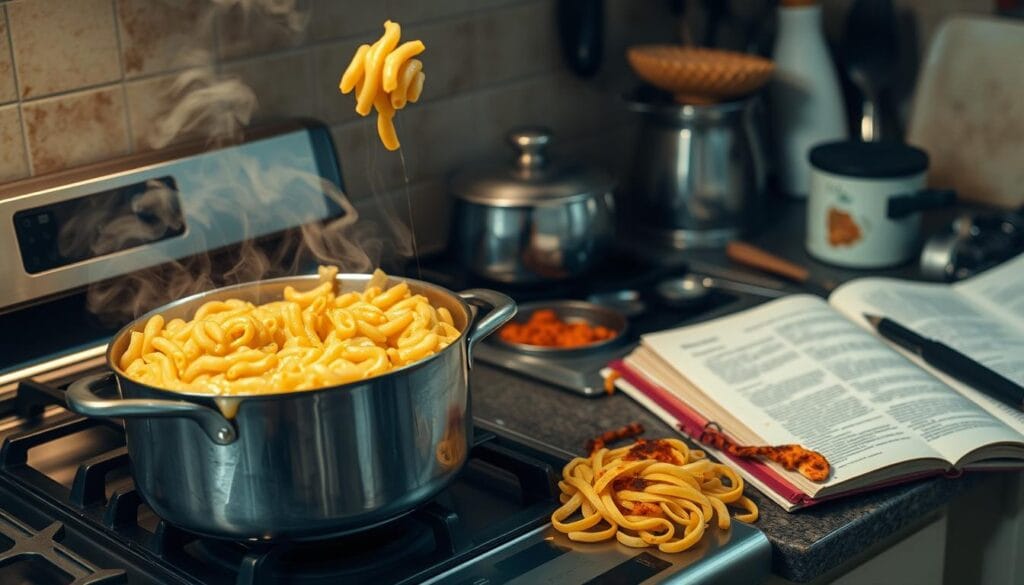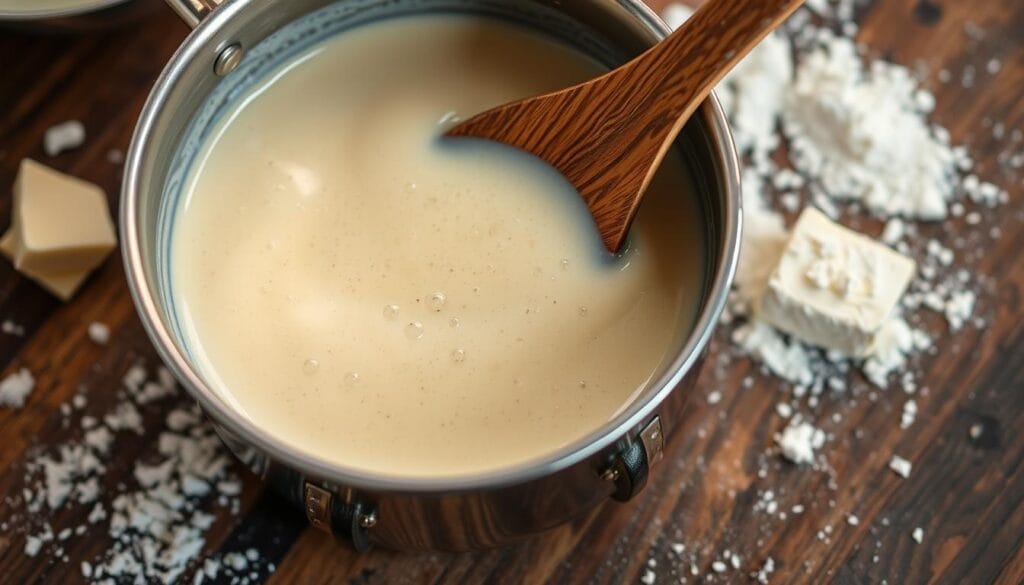I remember the first time I had a bad mac and cheese. It was greasy and unappetizing. This classic comfort food can bring back warm memories of childhood. But, only if it’s made right.
Many home cooks make mistakes that ruin the dish. We’ll look at these mistakes and how to avoid them. This way, you can make a creamy, cheesy mac and cheese that everyone will love.
Some common mistakes include using the wrong cheese or overcooking the pasta. But, with the right knowledge, you can make a perfect Mac and C. Let’s explore the mistakes to avoid and how to make a dish that everyone will enjoy.
Skipping the Cheese Quality Check
Creating the perfect mac and cheese starts with the right cheese. Skipping this step can ruin the dish. The best cheeses for mac and cheese melt well and add great flavors.
Why Cheese Quality Matters
Choosing the right cheese is key. Processed cheeses like American or Velveeta are easy but lack flavor. Go for high-quality cheeses for a creamy, rich dish.
Recommended Cheese Types
- Fontina Val d’Aosta: A semi-soft Italian cheese with a buttery, nutty flavor that melts beautifully.
- Comté: A French alpine cheese with a slightly sweet, complex taste that adds richness to mac and cheese.
- Appenzeller: A Swiss cheese with a slightly pungent aroma and a smooth, creamy texture.
- Raclette: A semi-firm Swiss cheese that has a high melting point, making it perfect for mac and cheese.
- Cowgirl Creamery’s Wagon Wheel or Hop Along: Artisanal American cheeses with unique flavors and excellent melting properties.
- Aged Cheddar: Look for a sharp, flavorful cheddar like Grafton Two-Year or Beecher’s Flagship to add depth and color to your dish.
For mac and cheese, mix at least three cheeses. Use an aged cheddar for flavor, a Swiss or Monterey Jack for texture, and parmesan or asiago for depth. Avoid using wrong cheese and focus on cheese quality for the best Mac and C.
Ignoring Measurements and Ratios
Creating the perfect mac and cheese requires precise measurements and the right ingredient ratios. If you ignore these, your dish might not turn out as expected. It could be too dry, too soupy, have unbalanced flavors, or an unpleasant texture.
The Importance of Pasta to Cheese Ratio
The pasta to cheese ratio is key for the right creaminess and richness in Mac and C. Aim for a ratio of 1:1 or 1:1.5. This means 1 cup of cooked pasta needs 1 to 1.5 cups of shredded cheese. Trying different cheeses, like cheddar, gruyère, and parmesan, can make the dish more complex and interesting.
Tools for Accurate Measuring
- Get a set of reliable measuring cups and spoons for the right amounts of ingredients.
- Use a digital kitchen scale for precise measurements of cheese and pasta.
- When making a roux, use equal parts flour and butter for a creamy sauce.
- Choose whole milk (3.25% milk fat) for the best texture and stability in your cheese sauce.
By focusing on measurements and ingredient ratios, you can make a mac and cheese that’s perfectly balanced and delicious in every bite.
Cooking Pasta Incorrectly
Making the perfect mac and cheese is more than just the cheese sauce. Properly cooked pasta is key. Avoid overcooking or undercooking and aim for al dente texture.
Overcooking vs. Undercooking
Overcooking pasta makes it mushy and unappealing. Undercooking makes it crunchy and unpleasant. The goal is to cook it until it’s tender but still firm.
Best Practices for Al Dente Pasta
- Start tasting the pasta a couple of minutes before it’s done. This helps find the perfect doneness.
- For baked mac and cheese, slightly undercook the pasta. It will cook more in the oven.
- Keep the cooked pasta hot while making the cheese sauce. This prevents the sauce from solidifying.
Mastering al dente pasta ensures your mac and cheese has the right texture and bite.
“Pasta should have a subtle bite, referred to as ‘al dente.’ Many pasta dishes are incorrectly served with a firm dry center or a mushy texture,” mentioned Chef John Underbrink at The Heritage.
Using the Wrong Cooking Method
The cooking method you pick can greatly affect your mac and cheese. The stovetop method is quick and creamy. But, baking it gives a richer flavor with a crispy top. Knowing the differences between these methods can help you avoid mistakes and get it just right.
Stovetop vs. Baked Mac and Cheese
The stovetop method is great for a fast mac and cheese. You make the cheese sauce on the stovetop and mix it with pasta. This way, you get a creamy dish in minutes. The secret is to make sure the cheese sauce coats the pasta well.
Baked mac and cheese, however, has a deeper flavor and a crispy top. You mix the cheese sauce with pasta and add a topping, then bake it. This method lets the flavors blend, making the dish more satisfying.
Common Mistakes in Cooking Method
There are mistakes to watch out for, no matter the method. For stovetop, not making the cheese sauce right or adding cold pasta can make it clumpy. With baked mac, not letting it cook long enough or undercooking the pasta can make it soggy.
To make sure your mac and cheese is perfect, follow the recipe closely. Pay attention to timing and temperatures. Adjust the method if you want a different taste or texture.

Forgetting to Season Your Dish
Creating a delicious mac and cheese starts with the right seasoning. Don’t let your dish lack flavor. Add spices and seasonings to make it stand out. Salt and pepper are essential, but you can also try more adventurous options.
Essential Seasoning Tips
Begin by seasoning the pasta water with salt. This gives the noodles flavor from the beginning. When making the cheese sauce, add nutmeg and mustard powder for depth. Seasoning Mac and C with spices like onion powder, garlic powder, and smoked paprika can also enhance it.
How to Enhance Flavor Profiles
- Try mixing different cheeses like sharp cheddar, Gruyère, and Parmesan for a richer taste.
- A bit of lemon juice can brighten the flavor and balance the richness of the flavor enhancers.
- For baked mac and cheese, season the breadcrumb topping with Parmesan, cheddar, and herbs for extra spices for Mac and C.
Seasoning is an art, not a science. Taste as you go and adjust the seasoning mac and cheese to your taste. With some experimentation, you’ll find the perfect flavor for your Mac and C.
Neglecting to Make a Roux
Creating a creamy mac and cheese is all about the roux. It’s a mix of flour and butter cooked together. This thickening agent is key for a creamy base.
What is a Roux?
To make a roux, melt butter in a pot. Then, whisk in an equal amount of flour. Cook for 4-5 minutes, stirring constantly, until it’s golden-yellow. This step prevents the cheese sauce from curdling.
Why Roux is Essential for Creaminess
- The roux thickens the cheese sauce, giving it structure.
- It mixes fat and liquid, making the sauce smooth and velvety.
- Without a roux, the sauce can be thin and separate.
Not making a roux can ruin your mac and cheese. It makes the dish creamy and rich. Your guests will love it.

“A well-made roux is the foundation for a silky-smooth, creamy cheese sauce that coats every nook and cranny of the pasta.”
Disregarding Mixing Techniques
Making a smooth, creamy mac and cheese needs the right mixing. Skipping this step can ruin the dish, causing clumpy cheese sauce and oily separation.
The Right Way to Incorporate Cheese
To make a smooth cheese sauce, add grated cheese slowly to the Béchamel sauce while whisking. This keeps the cheese oils mixed well, avoiding a grainy texture.
When adding milk to the roux, pour it slowly while stirring. This prevents lumps from forming.
Avoiding Clumps and Separation
- Whisk the cheese into the sauce in small batches, allowing each addition to fully incorporate before adding more.
- Avoid overheating the cheese sauce, as this can cause the emulsion to break, leading to a grainy consistency.
- If any lumps do form, whisk vigorously until they disappear.
By following these simple mixing techniques, your mac and cheese will be creamy and smooth. It will be free of clumps and separation. This care will make your dish a hit with family and friends, thanks to a delicious creamy cheese sauce.
| Ingredient | Amount |
|---|---|
| Elbow Macaroni | 16 ounces, uncooked |
| Butter | 6 tablespoons (85 g), cut into cubes |
| Evaporated Milk | 12 ounces can |
| Half & Half | 2 cups (480 ml) |
| Whole Milk | ½ cup (120 ml) |
| Sharp Cheddar Cheese | 16 ounces, shredded (about 4 cups) |
| Velveeta Cheese | 8 ounces, cut into cubes |
| Salt | ¼ teaspoon |
| Pepper | ¼ teaspoon |
“The key to a smooth, creamy mac and cheese is all in the technique. Slow and steady wins the race when it comes to [mixing cheese sauce] and [incorporating cheese] into the dish.”
Choosing Low-Fat or Non-Dairy Products
Choosing the right dairy products is key to making great mac and cheese. Low-fat or non-dairy options can change the flavor and texture. It’s important to know the differences and find the best substitutes for creaminess.
Understanding the Impact on Flavor
Whole milk is best for mac and cheese because of its texture and stability. If you use 2% milk, adding a bit of whipping cream can help. This mix increases the fat and makes it creamy again.
For non-dairy, pick options with a neutral taste and more fat. Soy or hemp milk are good choices. Avoid oat milk because it can make the dish too sweet. Skim milk is not good because it can make the mac and cheese watery or oily.
Best Alternatives for Creaminess
- Soy milk or hemp milk: These alternatives provide a neutral flavor profile and higher fat content, helping to achieve a creamy texture.
- Cashew milk: With its naturally creamy consistency, cashew milk can be an excellent substitute for dairy milk in mac and cheese.
- Coconut milk: The rich, velvety texture of coconut milk can add a touch of indulgence to your low-fat or non-dairy mac and cheese.
- Cream cheese: A small amount of cream cheese can help to enhance the creaminess of your mac and cheese, even when using low-fat or non-dairy products.
Success comes from balancing flavor, texture, and health. Try different mixes of dairy and non-dairy to find the perfect low-fat or non-dairy mac and cheese. It should be delicious without sacrificing taste.
Skipping a Taste Test
When making the perfect mac and cheese, taste testing is key. It’s the only way to get the flavors right. You need to taste your dish as you cook to balance the flavors.
Why Tasting is Crucial
Tasting as you cook lets you adjust the dish. You can check if the pasta is done and if the cheese sauce is seasoned right. Without tasting, your mac and cheese might not impress your guests.
Adjusting Flavors After Tasting
If your taste testing shows the dish needs more, don’t hesitate to adjust the flavors. Add a bit more salt or pepper to boost the taste. You might also want to add more cheese for a creamier texture. A quick taste can turn a good Mac and C into an amazing one.
“Tasting your mac and cheese as you go is the key to achieving the perfect balance of flavors.”
Feel free to try different flavors until you find what you like. By taste testing and adjusting flavors as you go, you’ll make a Mac and C that’s truly special.
Not Storing Leftovers Properly
To keep your homemade mac and cheese fresh, it’s key to store and reheat it right. Always put leftovers in an airtight container in the fridge for 3-5 days.
How to Store Leftover Mac and Cheese
Using an airtight container is vital to keep your mac and cheese moist and fresh. Place it in the fridge for 3-5 days. You can also freeze it for 2-3 months. Just thaw it in the fridge before you reheat it.
Reheating Tips for Best Results
When reheating, skip the microwave to avoid grainy cheese. Use low heat on the stovetop, stirring often. Add milk if it gets too thick.
For baked mac and cheese, the oven is best. Heat it at 350°F (175°C) with foil to keep it moist. Make sure it reaches 165°F (74°C) before serving.
FAQ
What not to do when making mac and cheese?
Avoid using only cheddar cheese and skimping on seasoning. Choose the wrong pasta shape and overcook the noodles. Use a mix of cheeses for depth and don’t forget to salt the pasta water.
Choose short pasta shapes to hold the sauce. Cook the pasta al dente to prevent mushiness.
Why does cheese quality matter for mac and cheese?
High-quality cheese is key for great mac and cheese. Use a mix of cheeses for complex flavors and texture. Recommended cheeses include Fontina Val d’Aosta, Comte, and aged cheddar.
Avoid processed cheeses like American or Velveeta. They lack flavor.
What is the right pasta-to-cheese ratio for mac and cheese?
Use accurate measuring tools for the right balance. The pasta-to-cheese ratio is crucial for creaminess and flavor. Use at least three different cheeses.
When making a roux, use equal parts flour and butter. For milk, use whole milk (3.25% Milk Fat) for the best texture.
How should I cook the pasta for mac and cheese?
Properly cooked pasta is key. Avoid overcooking or undercooking. Aim for al dente pasta.
Start tasting the pasta two minutes before the package suggests draining. For baked mac and cheese, slightly undercook the pasta before adding it to the cheese sauce.
What’s the difference between stovetop and baked mac and cheese?
Stovetop methods are quicker and creamier. Baked mac and cheese has a crispy top and more complex flavors. Avoid mistakes like not preparing the cheese sauce properly.
For baked mac and cheese, slightly undercook the pasta before baking to prevent mushiness.
What seasonings are essential for mac and cheese?
Essential seasonings include salt, pepper, nutmeg, and mustard. Consider adding onion powder, garlic powder, and smoked paprika for extra flavor. Season the pasta water generously with salt.
Taste the cheese sauce before adding it to the pasta. Use a mix of cheeses and add a few drops of lemon juice to brighten the taste. Season the breadcrumb topping with grated parmesan, cheddar, and herbs.
What is a roux and why is it important for mac and cheese?
A roux is a mixture of flour and butter, cooked together to thicken sauces. It’s essential for a creamy base in mac and cheese. To make a roux, melt butter, whisk in flour, and cook for 4-5 minutes.
How should I mix the ingredients for smooth, creamy mac and cheese?
Proper mixing techniques are crucial. Add grated cheese to the Bechamel sauce gradually, whisking constantly. This prevents oil separation during cooking.
Add milk to the roux slowly while stirring constantly to prevent lumps.
Can I use low-fat or non-dairy products for mac and cheese?
Low-fat or non-dairy products can affect flavor and texture. Whole milk (3.25% Milk Fat) is recommended for the best texture. If using 2% milk, add whipping cream in a 1:3 ratio to increase fat content.
For non-dairy options, choose alternatives with neutral profiles and higher fat content. Avoid oat milk, which can impart a nutty sweetness.
How important is tasting during the cooking process?
Tasting throughout the cooking process is crucial. Taste the pasta for doneness, the cheese sauce for seasoning, and the final dish before serving. Adjust flavors as needed.
Taste the breadcrumb topping mixture before adding it to the mac and cheese to ensure it has enough flavor.
How should I store and reheat leftover mac and cheese?
Store leftovers in an airtight container in the refrigerator for up to 3-5 days. Avoid using a microwave as it can cause the cheese to become grainy. Instead, reheat on the stovetop over low heat, stirring constantly.
For baked mac and cheese, reheat in the oven at 350°F (175°C) covered with foil to prevent drying out.

